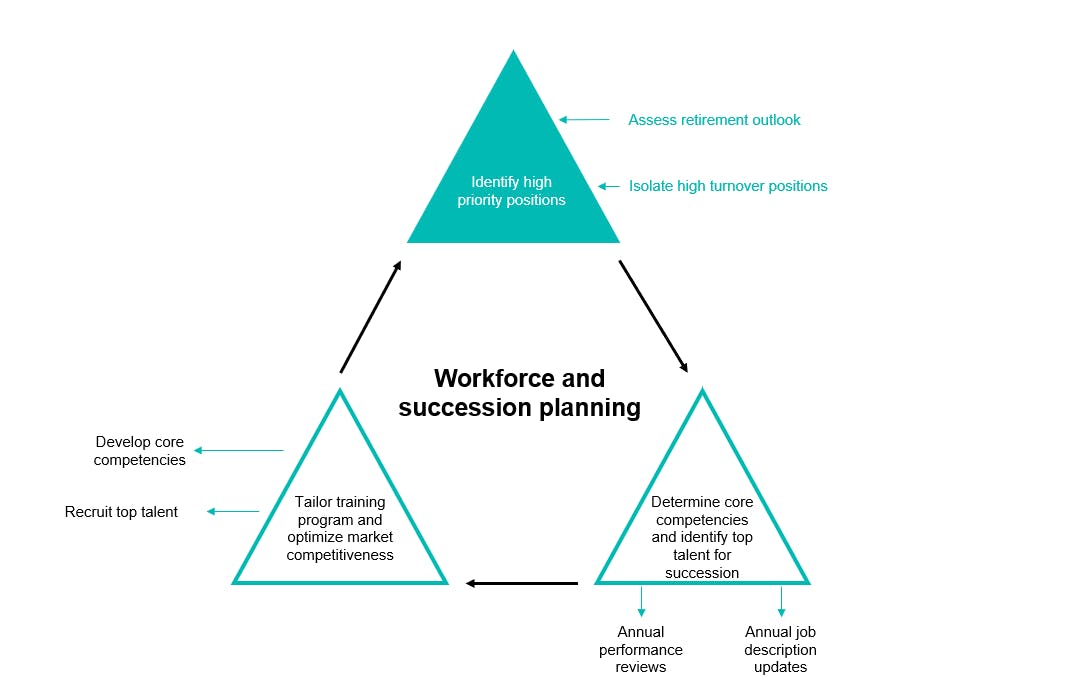
Workforce and succession planning – part 1: getting started
The competitive labor market, higher vacancy rates, and an increased volume of retirements are driving government entities, public utilities and not-for-profit organizations to adopt workforce and succession plans.
Workforce and succession planning programs complement an organization’s need to develop and engage staff to increase retention and often fit into processes and programs that likely already exist within your human resources services. The amount of time and budgetary resources spent implementing a plan can be minimal and the benefits enormous.
This is the first part in Baker Tilly’s three-part workforce and succession planning series which breaks down planning into specific actions you can immediately implement. The diagram below provides an overview of the workforce and succession planning process and the key steps that tie into a successful program. In this article, you will learn about defining your organization’s outlook, identifying critical positions, and prioritizing the positions to include in your workforce/succession plan.

Step 1: Identify potential critical positions
Critical positions are those essential for carrying out your organization’s mission, mitigating risk, and providing core services; without extremely capable people filling these roles, future success will be compromised. Critical positions extend beyond those in leadership (city/county manager, directors, etc.) or those with upcoming retirements.
Think outside the box. Niche positions such as a cybersecurity program administrator could be considered critical as could front-line positions that provide direct service to customers. Review all positions on your payroll for their impact on the organization. Identify the positions that if left vacant for long will severely impact the organization’s operations or pose a high safety, financial or liability risk. We recommend considering 10 to 15% of an organization’s workforce as critical to include in the workforce and succession planning program.
With a list of critical current positions in-hand, use the following questions to formulate discussion around each potential critical position and its future in your organization.
- How will the state of the industry today affect business operations for the next one to five years? And five to 10 years?
- What operations are critical to the future of your industry?
- Will reengineering, process improvement or technology impact how work is done in the future?
- What job functions, if any, will be consolidated?
- Will the projected workload volume of work increase or decrease?
- Will staffing levels change? If so, how?
- What skills and abilities will be needed to match these changes?
- Will the positions be discontinued or downsized? Or will they grow or remain constant?
This discussion will help define potential critical positions in your organization. A position you thought would be critical may not actually be relevant in five years. Meanwhile there may be a critical need for a new position not currently on staff. Once this exercise is complete, you will have a preliminary list of critical positions independent of retirement and vacancy considerations.
Step 2: Define your organization’s outlook: retirements and high turnover positions
As with any project, you have to understand the current state of your organization before you can plan where you want to go and how you will get there. This starts by having a clear picture of your future workforce needs. Two primary data inputs will paint this picture:
- Retirements: Which positions have employees that will be eligible for retirement or early retirement within the next five years? This analysis can be performed in most organizations by using an employee’s age, hire date/years of service and rules that govern retirement eligibility.
- High turnover positions: Which positions have historically had a high rate of turnover for reasons other than retirement, such as employee resignation or termination?
After gathering the data, arrange it by department or division to identify the teams with the highest number of eligible retirees and vacancy rates to begin conceptualizing which areas have the largest need for workforce planning.
The table below illustrates a sample data set for a human resources department and a finance department.
In this example, the finance department faces a more serious situation than the human resources department. Not only are 60% of finance employees eligible for retirement within the next five years, but one of the nonretirement eligible positions (accounting clerk) has historically high turnover. It is also important to look at the potential “succession paths” when reviewing this data. If the finance director, accounting manager and one of the accountants retired within the same year, would the remaining accountant or accounting clerk have the skills to perform the finance director or accounting manager duties on an interim basis?
Step 3: Prioritize positions for workforce and succession plan inclusion
In an ideal world, we would have unlimited time and budgets to create a workforce/succession plan for every position in the organization. In reality, time and monetary resources need to be prioritized.
Crosscheck your critical positions list (step 1) against your potential retirements and high turnover positions list (step 2) to develop a list of prioritized positions. Positions with high turnover and/or high potential for retirement within the next five years that are also listed as critical should be deemed high priority positions. Resources needed to develop a workforce/succession plan should be routed first to these prioritized positions. Dedicate any remaining resources to the other critical positions. At this point, if resources remain, allocate them to positions with upcoming retirements or high turnover.
What’s next? Determining core competencies and identifying top talent for succession
In part two of Baker Tilly’s three-part series on workforce and succession planning, public and not-for-profit organizations will learn how to define position competencies and update job descriptions, identify succession candidates, conduct performance reviews, and tie organizational assessments into the workforce and succession planning process.
Check out the full workforce and succession planning series:
For more information on this topic, or to learn how Baker Tilly workforce and succession planning specialists can help, contact our team.
